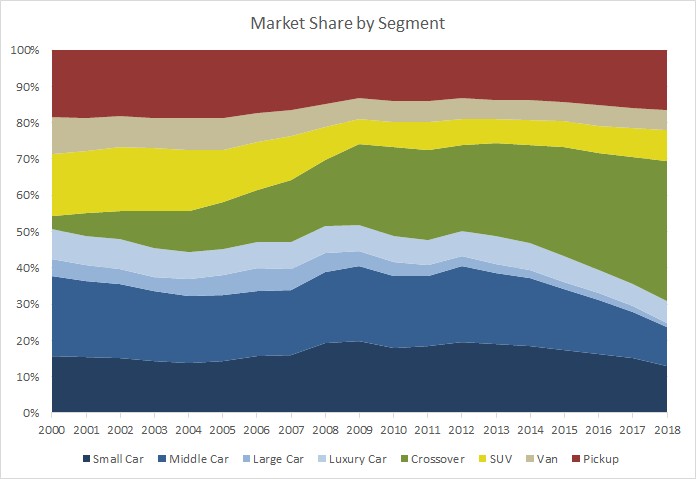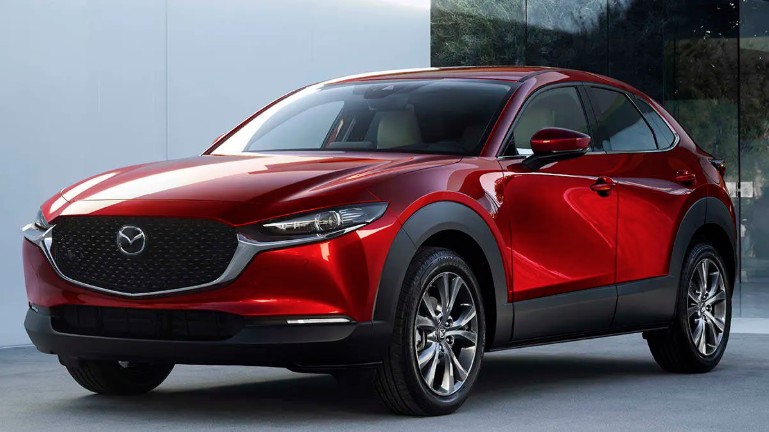Over the last two decades, the automotive world has witnessed a significant shift in consumer preference, marked by the increasing dominance of a vehicle type known as the crossover SUV. These versatile vehicles have surged in popularity, growing from a small niche to a major force in the market. In fact, crossover SUVs have expanded from representing less than 4% of the market in 2000 to nearly 40% by 2018. This growth has impacted both traditional car and larger vehicle segments, including pickups, minivans, and SUVs, as illustrated in Figure 1.
 Market Share Shift to Crossover SUVs: Crossover SUVs Gain Popularity at the Expense of Cars and Larger Vehicles
Market Share Shift to Crossover SUVs: Crossover SUVs Gain Popularity at the Expense of Cars and Larger Vehicles
Figure 1. Shift in Light Vehicle Market Share by Vehicle Class (Data Source: Wards Intelligence)
Even if you’re unfamiliar with the specific term, you’ve undoubtedly seen crossover SUVs on the roads. According to Wards Intelligence, a leading industry analysis firm, a crossover SUV is defined as a vehicle with “typically wagon body style with unibody construction, front or all-wheel drive and passenger vehicle qualities being the dominant characteristic with limited off-road capability.” Essentially, crossover SUVs are enhanced station wagons or hatchbacks, often styled to resemble traditional SUVs, but engineered for car-like driving and handling, with limited capability for serious off-road adventures. A key characteristic is their construction on car platforms. For instance, the widely popular Toyota RAV4 crossover SUV shares its platform with the Camry and Corolla sedans. This is a significant distinction from traditional SUVs, which are built for more rugged off-road performance and frequently utilize robust pickup truck frames. Another key difference lies in fuel efficiency. Crossover SUVs generally offer better gas mileage, averaging around 26 mpg, with top models achieving fuel economy comparable to cars. In contrast, traditional SUVs average closer to 19 mpg, only marginally better than pickup trucks.
The growing popularity of crossover SUVs, however, is sometimes obscured by the common practice of grouping pickup trucks, SUVs, and crossover SUVs into a single category labeled “light trucks.” This broad categorization can create a misleading impression of consumer demand. In recent years, this has led to news reports suggesting that consumers primarily desire large SUVs and pickup trucks. Carmakers have, at times, reinforced this narrative, as larger vehicles tend to be more profitable. However, this perception is inaccurate. The reality is that the majority of “light truck” sales are actually driven by smaller crossover SUVs, while traditional SUVs and pickup trucks each accounted for less than 20% of “light truck” sales in 2018.
The true story behind the automotive market shift is that consumers have transitioned from conventional sedans and boxy SUVs to vehicles that offer a blend of station wagon and hatchback practicality with more appealing designs and effective marketing. These crossover SUVs provide a driving experience similar to traditional cars, but with increased passenger and cargo space, and only a modest compromise in fuel economy and cost. Consider the top-selling crossover SUVs like the Toyota RAV4, Honda CR-V, and Nissan Rogue. They achieve only about 10% less fuel economy on average compared to the top three midsize sedans (Toyota Camry, Honda Accord, Nissan Altima), yet offer approximately 1.5 times more cargo capacity. Furthermore, the average price of a midsized crossover SUV is only about 5% higher than that of an average midsized car.
The value proposition of crossover SUVs has attracted buyers from both sedan owners seeking greater utility and SUV/pickup truck owners looking for more economical and fuel-efficient options. The rise of the crossover SUV demonstrates a clear consumer preference for vehicles that effectively combine practicality with good fuel economy.
 Mazda CX-30 Crossover SUV: Stylish Compact Crossover SUV Design
Mazda CX-30 Crossover SUV: Stylish Compact Crossover SUV Design
Pictured: the new Mazda CX-30 crossover SUV
